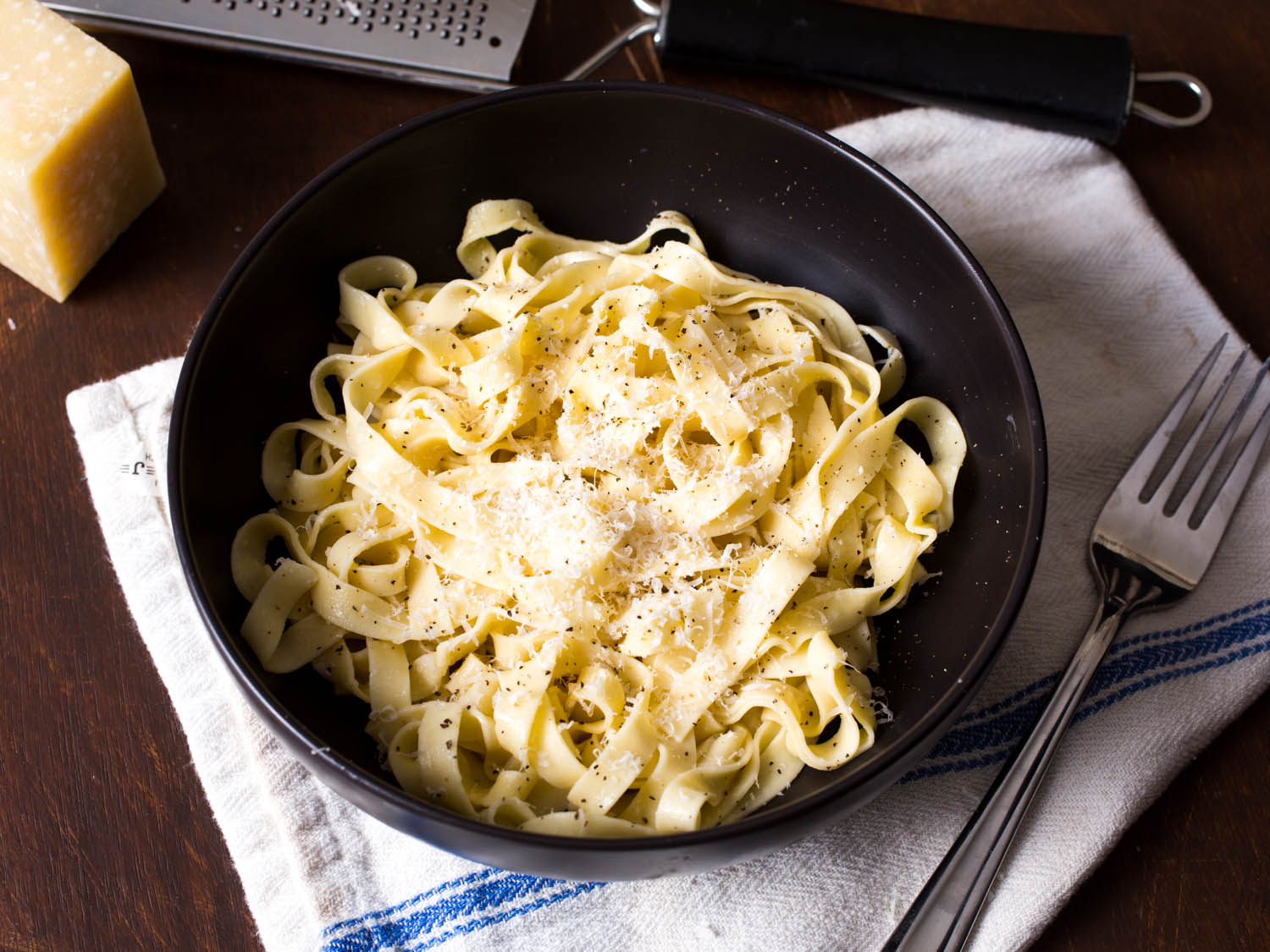I used this pasta for the lasagna recipe. I rolled to a 6 (Kitchenaid), next time I think 4 is probably thin enough.

Making fresh pasta can be an intimidating process, especially if you’re not used to working with flour and water. But it’s also an imminently achievable skill, and once you’re comfortable with the basic technique, there’s really no reason why you can’t reap the rewards on a regular basis. This recipe is for a light, springy, delicate fresh pasta that’s as well-suited to slicing into noodles as it is to making stuffed pastas, which require super-thin, pliable sheets of dough.
Why It Works
- Using a higher ratio of egg yolks to egg whites ensures delicate, rich, yellow noodles with a classic Italian flavor and texture.
- Kneading by hand allows for optimal control over the quality of the dough.
- Adding salt to the dough provides a more balanced flavor.
Ingredients
- 10 ounces (280g; about 2 cups) all-purpose flour, plus more for dusting (I used 00 flour)
- 2 whole large eggs (110g; about 4 ounces)
- 4 yolks from 4 large eggs (70g; about 2.5 ounces) (I ended up using almost a whole extra egg)
- 1 teaspoon kosher salt, plus more for salting water
Directions
To Make the Dough: On a large, clean work surface, pour flour in a mound. Make a well in the center about 4 inches wide. Pour whole eggs, egg yolks, and salt into well and, using a fork, beat thoroughly. When combined, gradually incorporate flour into the eggs until a wet, sticky dough has formed.
- Using a bench knife, scrape excess dough from fork and fingers. Begin to fold additional flour into the dough with the bench knife, turning the dough roughly 45 degrees each time, until dough feels firm and dry, and can form a craggy-looking ball, 2 to 5 minutes.
- Press the heel of your hand into the ball of dough, pushing forward and down. Rotate the ball 45 degrees and repeat. Continue until dough develops a smooth, elastic texture similar to a firm ball of Play-Doh. If dough feels too wet, add flour in 1 teaspoon increments. If dough feels too dry, add water slowly using a spray bottle.
- Wrap ball of dough tightly in plastic wrap and rest on countertop for 30 minutes.
To Roll the Pasta: Meanwhile, place a sheet of parchment paper on a tray or cutting board and dust lightly with flour. Unwrap rested dough and cut into quarters. Set one quarter on work surface and re-wrap remaining dough. With a rolling pin, flatten the quarter of dough into an oblong shape about 1/2 inch thick.
- Set pasta maker to widest setting and pass dough 3 times through the machine at this setting.
- Place dough on a lightly floured work surface. Fold both ends in so that they meet at the center of the dough, and then fold the dough in half where the end points meet, trying not to incorporate too much air into the folds. Using rolling pin, flatten dough to 1/2-inch thick. Pass through the rollers 3 additional times.
- Narrow the setting by 1 notch and repeat Step 7. Repeat once more (the dough should now have passed through the third widest setting). Continue passing the dough through the rollers, reducing the thickness by 1 setting each time until it reaches the desired thickness. It should now be very delicate and elastic to the touch, and slightly translucent.
- Place rolled dough onto a work surface or baking sheet lightly dusted with flour or lined with parchment paper, folding the dough over as necessary so that it fits; sprinkle with flour or line with parchment between folds to prevent sticking.
- Cover dough with plastic wrap or a kitchen towel to prevent drying, then repeat Steps 5 through 9 with remaining dough quarters. If making noodles, cut dough into 12- to 14-inch segments.
To Cut Noodles: Adjust pasta machine to noodle setting of your choice. Working one dough segment at a time, feed dough through the pasta-cutter. Alternatively, cut folded dough by hand with a chef’s knife to desired noodle width.
- Divide the cut noodles into individual portions, dust lightly with flour, and curl into a nest. Place on parchment-lined rimmed baking sheet and gently cover with kitchen towel until ready to cook. Pasta can be frozen directly on the baking sheet, transferred to a zipper-lock freezer bag, and stored in the freezer for up to three weeks before cooking. Cook frozen pasta directly from the freezer.
To Cook: Bring a large pot of salted water to a rolling boil. Add pasta, stir gently with a wooden spoon, chopsticks, or a cooking fork, and cook, tasting at regular intervals until noodles are just set with a definite bite, about 1 1/2 to 2 minutes. Drain, toss with sauce, and serve.


